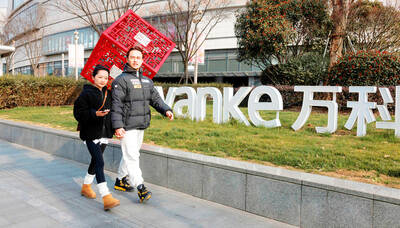Construction on Taipei's long-awaited Nangang Exhibition Hall is likely to miss its deadline again in April, an unfortunate turn of events for the nation's exhibition industry at a time when neighboring countries are gearing up to grab a share of the market with their mega-size expo venues.
The hall was originally scheduled for completion last June but had been delayed until April.
Construction has since fallen behind schedule and the completion date will likely be pushed back once again, an official at the Taiwan External Trade Development Council (TAITRA, 外貿協會), the hall operator, said during a telephone interview yesterday.
In the original plan, the hall would have been transferred to TAITRA in September and thereby facilitate preparations for next year's exhibitions.
TAITRA won the right last June to operate the Nangang hall for a period of 10 years.
TAITRA has sent an official document requesting a new completion date to the Bureau of Foreign Trade under the Ministry of Economic Affairs, which oversees construction of the hall, but has yet to receive a reply, a TAITRA official, who refused to be identified, said.
The Nangang Exhibition Hall is expected to open its doors for the first expo in March next year.
TAITRA has planned to house part of Computex Taipei -- the second-largest IT trade fair after Germany's CeBIT -- Food Taipei, Taipei Cycle, Taipei International Auto Parts and Accessories Show and the Taipei International Automobile Electronics Show in the new hall.
The three favored expo halls at the Taipei World Trade Center (TWTC) -- which can only accommodate a total of 2,500 booths -- located in the bustling Xinyi District, are no longer sufficient to host international expos.
In a bid to expand the scale of the exhibitions and compete with countries in the region, the Cabinet announced in June 2003 it would build the nation's largest expo and conference center in Nangang, with construction costs estimated at NT$3.6 billion (US$110 million), the TWTC Web site said.
The new hall, with seven floors and two underground levels -- for a total floor space of 47,000m2 -- will be able to accommodate more than 2,600 booths.
It nevertheless remains smaller than those found in China.
Hong Kong's exhibition center at Hong Kong International Airport, for example, was launched last year with a floor space of 66,000m2.
In line with Las Vegas' operational mode, Macau's new exhibition center will open its doors for business this year with a floor space of 74,000m2, a report in the Chinese-language Commercial Times said yesterday.
Expo halls in Shanghai, Dalian and Suzhou all have exhibition spaces of over 70,000m2, the report added.
South Korea, meanwhile, has decided to allot a piece of land of more than 10 hectares to build a large-sized exhibition venue.
Facing this type of competition, TAITRA said it hopes construction at Nangang Hall can be completed as soon as possible -- if not on time -- before pushing for a "second-generation" exhibition hall.
The "first-generation" hall under construction only occupies one-third of the land.
The remainder will be developed into hotels, shopping malls and offices, which should help turn Taiwan into a world-class expo location, TAITRA chairman Hsu Chih-jen (

CHIP RACE: Three years of overbroad export controls drove foreign competitors to pursue their own AI chips, and ‘cost US taxpayers billions of dollars,’ Nvidia said China has figured out the US strategy for allowing it to buy Nvidia Corp’s H200s and is rejecting the artificial intelligence (AI) chip in favor of domestically developed semiconductors, White House AI adviser David Sacks said, citing news reports. US President Donald Trump on Monday said that he would allow shipments of Nvidia’s H200 chips to China, part of an administration effort backed by Sacks to challenge Chinese tech champions such as Huawei Technologies Co (華為) by bringing US competition to their home market. On Friday, Sacks signaled that he was uncertain about whether that approach would work. “They’re rejecting our chips,” Sacks

Taiwan’s long-term economic competitiveness will hinge not only on national champions like Taiwan Semiconductor Manufacturing Co. (TSMC, 台積電) but also on the widespread adoption of artificial intelligence (AI) and other emerging technologies, a US-based scholar has said. At a lecture in Taipei on Tuesday, Jeffrey Ding, assistant professor of political science at the George Washington University and author of "Technology and the Rise of Great Powers," argued that historical experience shows that general-purpose technologies (GPTs) — such as electricity, computers and now AI — shape long-term economic advantages through their diffusion across the broader economy. "What really matters is not who pioneers

BUBBLE? Only a handful of companies are seeing rapid revenue growth and higher valuations, and it is not enough to call the AI trend a transformation, an analyst said Artificial intelligence (AI) is entering a more challenging phase next year as companies move beyond experimentation and begin demanding clear financial returns from a technology that has delivered big gains to only a small group of early adopters, PricewaterhouseCoopers (PwC) Taiwan said yesterday. Most organizations have been able to justify AI investments through cost recovery or modest efficiency gains, but few have achieved meaningful revenue growth or long-term competitive advantage, the consultancy said in its 2026 AI Business Predictions report. This growing performance gap is forcing executives to reconsider how AI is deployed across their organizations, it said. “Many companies

China Vanke Co (萬科), China’s last major developer to have so far avoided default amid an unprecedented property crisis, has been left with little time to keep debt failure at bay after creditors spurned its proposal to push back a looming bond payment. Once China’s biggest homebuilder by sales, Vanke failed to obtain sufficient support for its plan to delay paying the 2 billion yuan (US$283.51 million) note due today, a filing to the National Association of Financial Market Institutional Investors showed late on Saturday. The proposal, along with two others on the ballot, would have allowed a one-year extension. All three